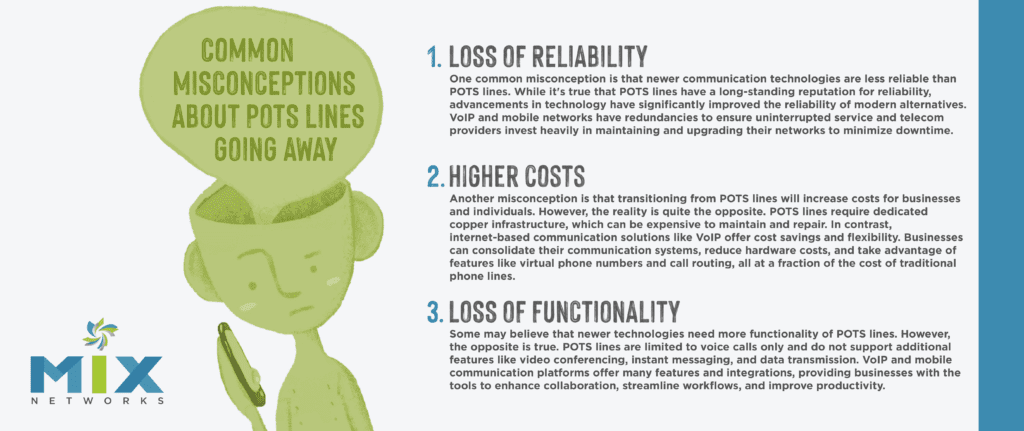Are you wondering why POTS lines are disappearing? In the age of digital communication, traditional analog phone lines are becoming obsolete. This article aims to shed light on the reasons behind the gradual phasing out of POTS, also known as Plain Old Telephone Service.
Advancements in technology, particularly the widespread adoption of internet-based communication methods, have made POTS lines increasingly unnecessary. With the rise of VoIP (Voice over Internet Protocol) and mobile phones, many businesses and individuals have opted for these more versatile and cost-effective alternatives.
One key reason for the decline of POTS is their limited capabilities compared to modern communication solutions. POTS lines can only handle voice calls and lack the flexibility to support additional features like data transmission and video conferencing.
Furthermore, maintaining and servicing aging copper infrastructure is becoming increasingly expensive. Telecom providers are transitioning to more efficient and sustainable networks, such as fiber-optic cables, which offer faster speeds and enhanced reliability.
As we delve into the factors driving the decline, we’ll explore the benefits of newer technologies replacing these outdated systems, providing businesses and individuals with improved communication options.
The Evolution of Telecommunications Technology
The telecommunications industry has come a long way since the days of traditional analog phone lines. For decades, Plain Old Telephone Service was the primary method of communication for businesses and households. These copper-based lines enabled voice calls, allowing people to connect across long distances.
However, as technology progressed, POTS lines began to show their limitations. The advent of the internet and digital communication brought about new possibilities and more efficient ways of transmitting voice and data. This led to the emergence of Voice over Internet Protocol (VoIP) and mobile phones, gradually replacing POTS lines as the go-to communication solutions.
Reasons Behind the Decline of POTS Lines
Several factors have contributed to the decline of POTS lines in recent years. One of the key reasons is the limited capabilities of POTS lines compared to newer technologies. While POTS lines can handle voice calls, they lack the flexibility to support additional features like data transmission and video conferencing. In today’s fast-paced business environment, where seamless communication and collaboration are essential, these limitations make POTS lines less appealing.
Moreover, POTS lines rely on aging copper infrastructure, which requires regular maintenance and servicing. As the infrastructure ages, the cost of maintaining it increases significantly. Telecom providers are shifting their focus towards more efficient and sustainable networks, such as fiber-optic cables. Fiber-optic technology offers faster speeds and enhanced reliability, making it a more attractive option for businesses and consumers.
Another reason for the decline of POTS lines is the rise of VoIP technology. VoIP utilizes an internet connection to transmit voice calls, bypassing the need for traditional phone lines altogether. This technology has gained popularity due to its cost-effectiveness and ability to integrate voice and data services seamlessly. VoIP also provides businesses greater flexibility, allowing employees to make and receive calls from anywhere with an internet connection.
Advantages of Newer Telecommunications Technologies
The emergence of newer telecommunications technologies, such as VoIP and mobile phones, has brought several advantages over POTS lines. These technologies offer greater versatility by enabling voice calls, video conferencing, instant messaging, and data transmission. This versatility allows businesses to streamline their communication processes and improve productivity.
Secondly, newer technologies provide more cost-effective solutions compared to POTS lines. Traditional phone lines often come with expensive monthly fees and additional charges for long-distance calls. In contrast, VoIP services typically have lower monthly costs and offer more affordable long-distance calling options. Mobile phones also provide flexibility and cost savings, eliminating the need for separate phone lines and allowing users to make calls on the go.
Furthermore, newer telecommunications technologies offer enhanced features and functionality. For example, VoIP services often include advanced call routing, voicemail-to-email transcription, and integration with other business applications. These features can significantly improve communication efficiency and enable businesses to deliver better customer service.
Impact on Businesses and Consumers
The decline of POTS lines and the adoption of newer telecommunications technologies have significantly impacted both businesses and consumers. The transition to more advanced communication solutions has opened up new opportunities and efficiencies for businesses. Companies can now leverage VoIP and mobile phones to establish virtual offices, allowing employees to work remotely and collaborate seamlessly. This flexibility improves work-life balance and reduces overhead costs associated with maintaining physical office spaces.
Additionally, integrating voice, data, and video channels has increased connectivity and improved customer service. Businesses can now engage with customers in multiple ways, whether through voice calls, video conferences, or instant messaging. This multi-channel communication approach enables faster response times and personalized interactions, ultimately enhancing the customer experience.
The shift away from POTS lines has provided greater convenience and flexibility for consumers. Mobile phones have become an essential part of everyday life, enabling people to stay connected while on the move. Moreover, the rise of VoIP services has allowed consumers to make international calls at significantly lower rates, breaking down barriers and fostering global communication.
Transitioning from POTS Lines to Alternative Solutions
Transitioning from POTS lines to alternative communication solutions may seem daunting, but it can be straightforward with the proper planning and resources. Here are some steps to consider when making the switch:
- Assess your communication needs: Evaluate your business or household’s specific requirements. Consider the number of phone lines needed, desired features, and budget.
- Research available alternatives: Explore the various telecommunications technologies available, such as VoIP providers and mobile phone plans. Compare their features, pricing, and reliability to find the best fit for your needs.
- Plan the transition: Develop a timeline and strategy for transitioning from POTS lines to the chosen alternative. Consider contract expiration dates, equipment requirements, and training needs.
- Notify stakeholders: Inform employees, customers, and relevant stakeholders about the upcoming transition. Provide clear communication regarding any changes in phone numbers, contact information, or communication processes.
- Set up the new system: Install and configure the chosen alternative solution. This may involve setting up VoIP phones, configuring mobile devices, or migrating existing phone numbers to the new service.
- Test and train: Conduct thorough testing to ensure proper functionality and compatibility with existing systems. Train employees or household members to familiarize them with the new communication tools and features.
- Monitor and optimize: Regularly monitor the new system’s performance and make adjustments as needed. Seek user feedback and address any issues promptly to ensure a smooth transition.
Challenges and Considerations During the Transition
The transition from POTS lines to more modern communication technologies is challenging. While the benefits of newer systems are clear, considerations still need to be addressed during this shift.
One of the primary challenges is ensuring a smooth transition for businesses that rely heavily on POTS lines. Many companies have complex phone systems and infrastructure, making switching to VoIP or other alternatives a daunting task. There may be compatibility issues, training requirements, and potential disruptions during migration.
Another consideration is the need for reliable internet connectivity. Unlike POTS lines that function independently of internet access, VoIP and other internet-based solutions require a stable internet connection. Businesses and individuals must carefully evaluate their internet service provider options and invest in robust networks to ensure uninterrupted communication.
Additionally, regulatory and legal considerations may be considered during the transition. POTS lines have long been subject to specific regulations, such as emergency service requirements and accessibility standards. As these lines phase out, similar regulations and standards must be established for the new communication technologies to ensure public safety and equal access for all.
Despite these challenges, the benefits of moving away from POTS lines outweigh the difficulties. Let’s explore some common misconceptions about POTS lines’ demise and highlight the advantages of newer communication technologies.
Common Misconceptions about POTS Lines Going Away
- Loss of reliability: One common misconception is that newer communication technologies are less reliable than POTS lines. While it’s true that POTS lines have a long-standing reputation for reliability, advancements in technology have significantly improved the reliability of modern alternatives. VoIP and mobile networks have redundancies to ensure uninterrupted service and telecom providers invest heavily in maintaining and upgrading their networks to minimize downtime.
- Higher costs: Another misconception is that transitioning from POTS lines will increase costs for businesses and individuals. However, the reality is quite the opposite. POTS lines require dedicated copper infrastructure, which can be expensive to maintain and repair. In contrast, internet-based communication solutions like VoIP offer cost savings and flexibility. Businesses can consolidate their communication systems, reduce hardware costs, and take advantage of features like virtual phone numbers and call routing, all at a fraction of the cost of traditional phone lines.
- Loss of functionality: Some may believe that newer technologies need more functionality of POTS lines. However, the opposite is true. POTS lines are limited to voice calls only and do not support additional features like video conferencing, instant messaging, and data transmission. VoIP and mobile communication platforms offer many features and integrations, providing businesses with the tools to enhance collaboration, streamline workflows, and improve productivity.
By debunking these misconceptions, it becomes clear why POTS lines are being phased out in favor of more modern alternatives. The benefits of these newer technologies are cost-effective and offer greater flexibility, reliability, and functionality.
In the next section, we will explore the specific advantages that VoIP and mobile communication solutions bring to the table, further highlighting why POTS lines are becoming obsolete.








